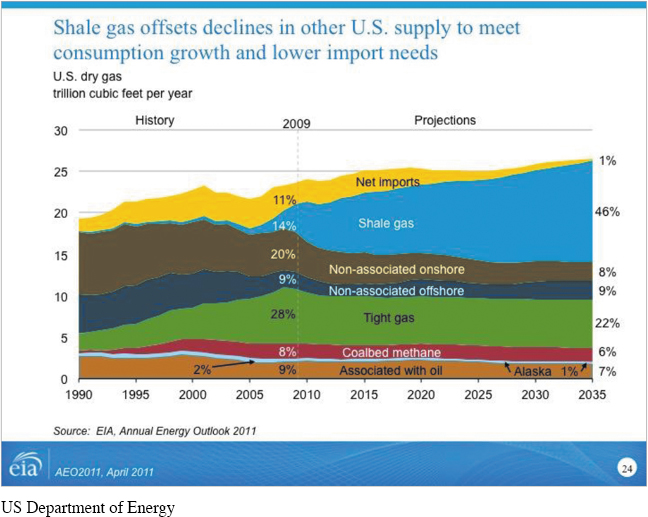Shale Gas Subcommittee, from Shale Gas Subcommittee 90-Day Report
The material below first appeared in a report by the Shale Gas Production Subcommittee for the U.S. Department of Energy in 2011.
FROM SHALE GAS PRODUCTION SUBCOMMITTEE 90-
1
The Subcommittee believes that the U.S. shale gas resource has enormous potential to provide economic and environmental benefits for the country. Shale gas is a widely distributed resource in North America that can be relatively cheaply produced, creating jobs across the country. Natural gas—

2
Domestic production of shale gas also has the potential over time to reduce dependence on imported oil for the United States. International shale gas production will increase the diversity of supply for other nations. Both these developments offer important national security benefits.1
3
The development of shale gas in the United States has been very rapid. Natural gas from all sources is one of America’s major fuels, providing about 25 percent of total U.S. energy. Shale gas, in turn, was less than 2 percent of total U.S. natural gas production in 2001. Today, it is approaching 30 percent.2 But it was only around 2008 that the significance of shale gas began to be widely recognized. Since then, output has increased four-
Page 544

4
The economic significance is potentially very large. While estimates vary, well over 200,000 jobs (direct, indirect, and induced) have been created over the last several years by the development of domestic production of shale gas, and tens of thousands more will be created in the future.3 As late as 2007, before the impact of the shale gas revolution, it was assumed that the United States would be importing large amounts of liquefied natural gas from the Middle East and other areas. Today, the United States is essentially self-
Page 545
Endnotes
1The James Baker III Institute for Public Policy at Rice University has recently released a report on Shale Gas and U.S. National Security, available at: http://bakerinstitute.org/
2As a share of total dry gas production in the “lower 48,” shale gas was 6 percent in 2006, 8 percent in 2007, at which time its share began to grow rapidly—
3Timothy Considine, Robert W. Watson, and Nicholas B. Considine, “The Economy Opportunities of Shale Energy Development,” Manhattan Institute, May 2011, Table 2, page 6.
AT ISSUE: SOURCES FOR DEVELOPING AN EVALUATION ARGUMENT
What position on fracking is taken by the authors of this report?
Do the visuals simply present information, or do they actually make an argument? Explain your reasoning.
This report was produced by a subcommittee for the U.S. Department of Energy. How do you think the affiliation of these writers might have influenced their ethos? How does their affiliation affect your response to the report?